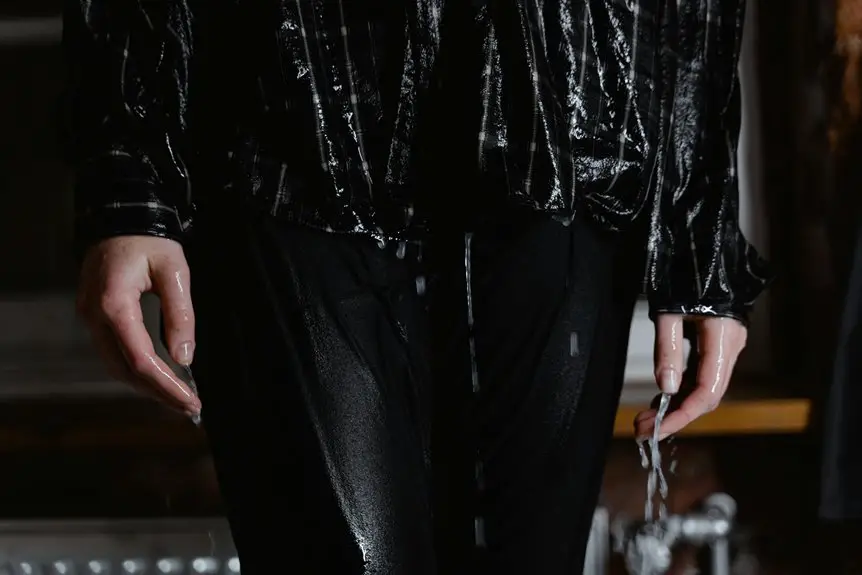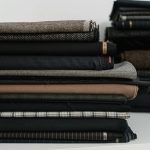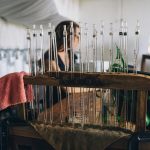When choosing activewear or outdoor gear, understanding MVTR—or Moisture Vapor Transmission Rate—can make a significant difference in your comfort. It measures how well a fabric lets moisture escape, impacting your breathability during physical activities. High MVTR values can keep you dry and cool, while low values might lead to discomfort. But how do these measurements work, and what factors influence them? Exploring these aspects can help you make better choices for your needs.
Table of Contents
Key Takeaways
- MVTR measures a fabric’s ability to allow moisture vapor to escape, indicating its breathability and comfort level during physical activities.
- Higher MVTR values (above 1000 g/m²) enhance moisture management, keeping users dry and preventing overheating.
- Standard testing methods for MVTR include ASTM E96 and ISO 15106, ensuring accurate and consistent measurement across fabrics.
- Factors affecting MVTR include temperature, humidity, material composition, and surface temperature, all influencing moisture transmission rates.
- MVTR is crucial for various applications, including athletic wear, medical textiles, and outdoor gear, impacting performance and comfort.
What Is MVTR?
MVTR, or Moisture Vapor Transmission Rate, measures how well a fabric allows moisture vapor to pass through it.
You might wonder why this matters. Fundamentally, MVTR indicates the breathability of a fabric, which can affect your comfort level during various activities. High MVTR values mean that the material can release sweat and moisture effectively, keeping you dry. Conversely, low MVTR fabrics can trap moisture, leading to discomfort.
When choosing clothing or gear, consider the MVTR rating to guarantee it meets your needs, particularly for active pursuits. Fabrics like Gore-Tex or various technical textiles typically boast high MVTR, making them ideal for outdoor activities.
Understanding MVTR helps you select the right materials for your lifestyle and preferences.
Importance of MVTR in Fabrics
When choosing fabrics for clothing or gear, understanding the importance of MVTR can greatly impact your comfort and performance. A fabric’s ability to manage moisture helps you stay dry and comfortable during various activities.
Here are four key reasons why MVTR matters:
Understanding MVTR is crucial for comfort, breathability, and temperature regulation in your clothing and gear.
- Breathability: High MVTR allows sweat to escape, preventing overheating.
- Comfort: Fabrics with good MVTR keep you feeling fresh and dry, especially during intense exercise.
- Durability: Moisture management can prolong fabric life, reducing wear and tear.
- Temperature Regulation: Proper MVTR helps maintain your body temperature, ensuring you stay warm in cold and cool in hot conditions.
Measuring MVTR: Units and Methods
When you measure MVTR, you’ll encounter various units and standard testing methods that can affect your results.
Understanding the right equipment for testing is essential to guarantee accuracy and consistency.
Let’s explore how these factors come together to give you a clear picture of a fabric’s moisture vapor transmission rate.
MVTR Measurement Units
Measuring moisture vapor transmission rate (MVTR) is essential for evaluating how well a fabric breathes.
Understanding the measurement units helps you compare fabrics effectively. Here are the most common units used for MVTR:
- g/m²/24h: This unit measures the grams of moisture that pass through one square meter of fabric in 24 hours.
- L/m²/24h: This indicates the liters of water vapor transmitted through one square meter of fabric in 24 hours.
- mg/cm²/h: This unit reports the milligrams of vapor passing through one square centimeter of fabric in one hour.
- Perms: This unit combines area and time, giving you a straightforward view of vapor transmission.
Familiarizing yourself with these units will make your fabric evaluations more effective.
Standard Testing Methods
Understanding the measurement units for MVTR is just the beginning; knowing how these values are obtained through standardized testing methods adds another layer to your fabric evaluation.
Several methods exist to measure MVTR, each with its own specific protocols. The most common are the ASTM E96 and ISO 15106 standards.
These tests involve placing a sample fabric over a controlled environment to assess how much moisture vapor passes through it over a set time. You’ll find results expressed in grams per square meter per day (g/m²/day).
Equipment for Testing
Several types of equipment are essential for accurately testing moisture vapor transmission rates (MVTR) in fabrics.
Choosing the right tools guarantees you get reliable results. Here are four key pieces of equipment you’ll need:
- Desiccant Method Apparatus: This setup uses desiccants to absorb moisture and measures weight changes over time.
- Cup Method: A simple setup where fabric samples are placed over a cup filled with water, measuring evaporation rates.
- Humidity Chamber: This controlled environment allows for testing under specific humidity levels, providing consistent results.
- Infrared Moisture Analyzers: These advanced devices use infrared technology to measure moisture levels quickly and accurately.
MVTR and Breathability: A Critical Relationship
While you might not think about it often, the relationship between moisture vapor transmission rate (MVTR) and breathability is essential when selecting fabrics for your needs. A high MVTR indicates that moisture can escape easily, enhancing comfort during physical activities. Breathable fabrics allow air circulation, preventing overheating and moisture accumulation.
| MVTR Rating | Breathability Level |
|---|---|
| Low (< 500 g/m²) | Poor |
| Medium (500-1000 g/m²) | Moderate |
| High (>1000 g/m²) | Excellent |
| Variable | Depends on conditions |
Choosing the right fabric with ideal MVTR guarantees you stay dry and comfortable. So, when you’re shopping for clothing or gear, don’t overlook this critical relationship!
Factors Affecting MVTR Values
When it comes to moisture vapor transmission rate (MVTR), several key factors come into play.
You’ll find that temperature, material composition, and humidity greatly influence how fabrics perform.
Understanding these elements can help you choose the right fabric for your needs.
Temperature Impact
As temperatures fluctuate, they can greatly influence the moisture vapor transmission rate (MVTR) of fabrics. Understanding this impact helps you choose the right materials for your needs.
Here are four key factors related to temperature:
- Heat: Higher temperatures typically increase MVTR, allowing more moisture to escape.
- Humidity: Warmer air holds more moisture, affecting how much vapor can be transmitted.
- Surface Temperature: The temperature of the fabric’s surface can create a gradient that aids in moisture movement.
- Temperature Gradient: A larger difference between the inside and outside temperatures boosts MVTR efficiency.
When you consider these factors, you can better select fabrics that perform well in varying temperatures, ensuring comfort and functionality.
Material Composition
Temperature isn’t the only factor that affects moisture vapor transmission rate (MVTR) in fabrics; material composition plays a significant role as well.
Different fibers have unique properties that influence how moisture moves through them. For instance, natural fibers like cotton and wool typically offer better breathability due to their porous structure, allowing for higher MVTR values.
On the other hand, synthetic materials like polyester and nylon can have varying MVTR rates depending on their weave and finish. Coatings and treatments also alter a fabric’s ability to transmit moisture.
If you’re choosing fabric for activewear or outdoor gear, consider the material’s inherent moisture management properties to guarantee peak comfort and performance. Understanding this aspect can greatly enhance your fabric selection process.
Humidity Effects
Humidity considerably impacts moisture vapor transmission rate (MVTR) values in fabrics, affecting how comfortable you feel in different environments.
When humidity levels rise, the fabric’s ability to release moisture can diminish, leading to discomfort.
Here are some factors to evaluate:
- High Humidity: In humid conditions, the air’s saturation makes it harder for moisture to escape, reducing MVTR.
- Low Humidity: Dry air encourages moisture evaporation, often increasing MVTR.
- Temperature: Warmer temperatures can enhance moisture transmission, even in high humidity.
- Fabric Type: Different materials react uniquely to humidity, influencing their overall MVTR performance.
Understanding these factors helps you select the right fabric for your needs, ensuring comfort in various conditions.
MVTR in Different Industries
MVTR, or Moisture Vapor Transmission Rate, plays a crucial role across various industries, influencing everything from athletic wear to medical textiles.
In sports apparel, you want fabrics that allow sweat to escape, keeping you dry and comfortable during intense activities.
In the medical field, textiles with specific MVTR properties help maintain sterile environments and guarantee patient comfort in garments and drapes.
Similarly, in the outdoor industry, breathable yet waterproof fabrics are essential for weather-resistant gear.
Even in construction, proper MVTR in materials can prevent moisture buildup, protecting structures.
Proper MVTR in construction materials is essential for preventing moisture buildup and ensuring structural integrity.
Understanding how MVTR affects each sector helps you make informed choices about the fabrics you use, guaranteeing you get the right performance for your specific needs.
Testing Protocols for Accurate MVTR Measurement
When measuring MVTR, it’s essential to follow standardized testing procedures to guarantee accuracy.
You’ll want to conduct tests in controlled environment conditions to eliminate variables that could skew your results.
This approach helps you obtain reliable data on the fabric’s moisture vapor transmission rate.
Standardized Testing Procedures
Accurate measurement of Moisture Vapor Transmission Rate (MVTR) relies on standardized testing procedures that guarantee consistency across different fabrics.
These procedures help guarantee that you get reliable results you can trust. Here are four key steps involved in standardized MVTR testing:
- Sample Preparation: Guarantee fabric samples are cut to the specified dimensions and conditioned properly.
- Testing Apparatus: Use a consistent testing device, like a cup or a dynamic vapor permeation tester.
- Weight Measurement: Accurately measure the weight of the water vapor lost over a set period.
- Data Analysis: Calculate the MVTR using the weight change, area, and time, guaranteeing you follow the established formulas.
Controlled Environment Conditions
To guarantee reliable MVTR measurements, it’s crucial to maintain controlled environment conditions during testing. You should verify that the temperature and humidity levels are consistent, as fluctuations can greatly impact your results.
Ideally, aim for a temperature around 20°C (68°F) and a relative humidity of 50%.
Before testing, acclimate the fabric samples to these conditions for at least 24 hours. During the test, keep air circulation stable, avoiding direct drafts that might influence moisture transfer.
Also, use calibrated equipment to accurately measure both the moisture loss and environmental parameters. By following these protocols, you’ll enhance the accuracy of your MVTR readings, confirming that your fabric performance data is reliable and trustworthy.
Applications of MVTR in Textile Performance
MVTR, or Moisture Vapor Transmission Rate, plays an essential role in determining how well fabrics perform in various applications.
Understanding MVTR helps you choose the right materials for specific uses, guaranteeing comfort and functionality.
Here are four key applications where MVTR is critical:
- Activewear: Fabrics with high MVTR keep you dry during workouts by allowing sweat to escape.
- Outdoor Gear: In jackets and tents, proper MVTR guarantees breathability, preventing moisture buildup while keeping you protected from rain.
- Medical Textiles: High MVTR in wound dressings promotes healing by managing moisture levels.
- Home Textiles: In bedding and upholstery, adequate MVTR prevents mold and mildew, enhancing longevity and comfort.
Balancing Waterproofing and Breathability
While you may prioritize waterproofing in certain fabrics, achieving the right balance with breathability is essential for overall comfort.
Fabrics that are completely waterproof can trap moisture inside, leading to discomfort and even overheating. You want a material that keeps water out while allowing sweat and moisture to escape.
Look for textiles with a good MVTR rating, as they indicate how well the fabric breathes. Manufacturers often use advanced technologies, such as microporous membranes or hydrophilic coatings, to enhance breathability without sacrificing waterproofing.
When choosing gear, consider your activity level and environment; if you’re active in wet conditions, prioritize breathability alongside waterproofing to maintain comfort and performance.
Your fabric choice can greatly impact your overall experience.
Future Trends in MVTR Research and Development
As the demand for high-performance fabrics continues to grow, researchers are exploring innovative ways to enhance MVTR. You’ll see exciting developments in the field that may revolutionize how we think about moisture management in textiles.
Here are some trends to watch:
Emerging trends in moisture management promise to enhance comfort and performance in high-performance fabrics.
- Nanotechnology: Utilizing nanoparticles to create ultra-thin coatings that improve breathability while maintaining waterproof properties.
- Biodegradable Materials: Developing sustainable fabrics that don’t sacrifice MVTR for environmental concerns.
- Smart Textiles: Integrating sensors that monitor moisture levels, adjusting fabric properties in real-time to optimize comfort.
- Hybrid Fabrics: Combining different materials to achieve superior MVTR without compromising other performance aspects.
These advancements promise to redefine your experience with fabrics, keeping you comfortable and dry in various conditions.
Frequently Asked Questions
How Does MVTR Impact Fabric Care and Maintenance?
When you dance with your fabrics, their breath matters. A high MVTR keeps them dry and fresh, letting you wash less often. It’s like a gentle breeze, ensuring your clothes stay vibrant and lively.
Can MVTR Levels Change Over Time in Fabrics?
Yes, MVTR levels can change over time due to factors like wear, washing, and exposure to environmental conditions. You’ll notice these shifts as fabrics age, affecting their breathability and overall performance. Keep an eye on them.
What Are the Environmental Impacts of High MVTR Materials?
High MVTR materials can be like a double-edged sword; they keep you comfortable but may contribute to water wastage and increased energy use. You’ll want to weigh the benefits against potential environmental costs carefully.
How Does MVTR Affect the Lifespan of Outdoor Gear?
MVTR greatly impacts your outdoor gear’s lifespan. When it’s too high, moisture can damage materials, causing wear and tear. Choosing the right MVTR helps maintain durability, ensuring your gear lasts through countless adventures.
Are There Regulations Governing MVTR in Textiles?
“An ounce of prevention’s worth a pound of cure.” While there aren’t universal regulations specifically governing MVTR in textiles, various industry standards and certifications guide manufacturers to guarantee quality and performance in their products.
- How Calico Fabric Is Made: From Cotton Boll to Printed Textile - June 19, 2025
- Where to Buy Calico Fabric: The Best Stores Online and In-Person - June 19, 2025
- The Complete Keepsake Calico Fabric Review: Is It Worth It? - June 19, 2025






